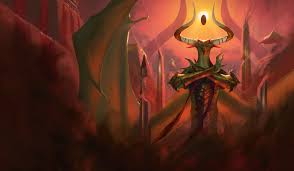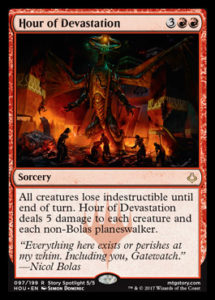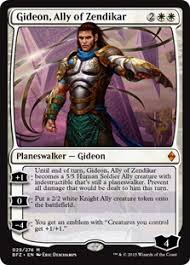The Final Hour

The Final Hours are upon us. Nicol Bolas has returned to claim Amonkhet, and true to form has come prepared. Gideon (and the other four) never stood a chance:

The God-Pharaoh’s glorious return promises much, and delivers much more. In a world of 5 mana boardwipes, this one’s packing some serious upside. Let’s break it down:
- Five damage to all creatures for five mana. Not an exciting deal to start with – white has given us a number of cleaner wraths in recent history (Fumigate and Planar Outburst both still legal in standard). We have some potential to set this up as a one-sided wrath if we can build our deck to present threats that can endure it, such as vehicles or Gearhulks.
- All creatures lose indestructible until end of turn. Now we’re talking! Giving us the option to take down the three most dangerous of Amonkhet’s Gods (Rhonas, Hazoret and Kefnet) along with any cohort they’ve brought with them helps to plug a serious hole in the control mage’s armour. It even lets us play around opposing Avacyns and Selfless Spirits.
- Damage to… planeswalkers? I had to do a double take on that one. This is an effect we haven’t seen in some time, and never alongside a wrath.
Put all of that together into one tidy package and we have ourselves a standard staple. Although Wizards of the Coast never planned for Battle for Zendikar block to still be legal in Standard, all the numbers on this card line up perfectly to give us an edge against Magic’s real bad guy:
Not so tough now, are you?
Gideon has spent the last two years beating up on control, aggro and midrange decks alike, and is arguably Standard’s most powerful card to have survived this year’s slew of bannings. With Felidar Guardian, Emrakul, the Promised End and Aetherworks Marvel gone, Gideon is poised to pick up his mantle from Pro Tour Kaladesh once more and pilot Mardu Vehicles to the top tables. Historically, a resolved Gideon has been game over for Blue-Red control players, who have had to reach for cards like Commit // Memory just to put away the planeswalker, then spend a second spell on the Knight Ally, if they were lucky. This would usually end up tying up 5+ mana over multiple turns, leaving you vulnerable to attacks from the creatures that preceded him.
Five damage happens to work out perfectly to take down Gideon and his Ally on turn 5 whether on the play or draw, as there’s not enough time for him to get out of range. On the play, we also get to kill on-curve Chandra, Torch of Defiance, Liliana, the Last Hope and Nissa, Voice of Zendikar. Given we’re looking now to untap and clear the board up on turn 5, we might as well spend turn 4 making sure we hit that crucial land drop and pull ahead on card advantage – Glimmer of Genius is the perfect complement to set up an Hour of Devastation.
Luckily for us, Bolas is no one-trick-pony, and Hour of Devastation is great across a multitude of matchups. This is a natural predator for decks like Zombies and Oketra’s Monument, who would look to flood the battlefield with a wide array of smaller creatures – even in the face of a Metallic Mimic, Lord of the Accursed and a Liliana’s Mastery, Hour of Devastation will still leave the board clean, giving us some much-needed breathing space to hit the all-important sixth land, where Torrential Gearhulk will start to take over the game.
Five is still a lot of mana though, and the aggro decks are only getting faster as the card pool hits eight sets – there’s a reasonable chance we may die before we get there. To properly take advantage of it, we’ll need some crutches to help us survive the early game – Magma Spray is perfect for this role. We can leverage it to keep Toolcraft Exemplars and Longtusk Cubs at bay, while also providing a way to permanently answer resilient threats such as Relentless Dead, Dread Wanderer and Scrapheap Scrounger, which are otherwise worth multiple cards against us over a longer game. All-in-all, Hour of Devastation fits right in to a classic Blue/Red control shell:
| Blue-Red Control (60 cards) | |
| Creatures (4): | Lands (26): |
| 4 Torrential Gearhulk | 4 Spirebluff Canal |
| 4 Wandering Fumarole | |
| Spells (30): | 2 Highland Lake |
| 4 Magma Spray | 4 Aether Hub |
| 4 Censor | 6 Island |
| 4 Harnessed Lightning | 6 Mountain |
| 2 Negate | |
| 1 Essence Scatter | |
| 3 Disallow | Sideboard (15): |
| 2 Sweltering Suns | 1 Sphinx of the Final Word |
| 4 Glimmer of Genius | 1 Kefnet the Mindful |
| 3 Hieroglyphic Illumination | 1 Dragonmaster Outcast |
| 2 Hour of Devastation | 2 Negate |
| 1 Pull from Tomorrow | 3 Dispel |
| 1 Summary Dismissal | |
| 4 Thing in the Ice | |
| 2 Release the Gremlins |
This is what I would start with. Whilst Sweltering Suns and Hour of Devastation cover many of the same bases, it’s key to not get overrun early. Very few contenders should be able to keep up with the power level and card advantage past turn 5, so it’s key to make sure we get there, especially against some of the lightning-fast draws that Mono-White monument and the Energy Aggro decks can produce. I could easily see it being right to skew the numbers upwards here with the amount of interaction and push for three copies of Hour, my only concern is not wanting to leave ourselves too cold to other control decks taking advantage of our heavy removal package.
Another consideration for this style of deck is Jace, Unraveler of Secrets. Savvy opponents may try to play around Hour of Devastation by leaving some of their resources in hand and slow-rolling their threats, or otherwise focusing on hitting their land drops. In doing so, they leave themselves vulnerable to a turn four spot-removal spell to clear their threat into a turn five Jace, which will very shortly bury them in cards if left unanswered. However, a number of black midrange decks have started to crop up in Marvel’s wake, many of which employ multiple copies of Never//Return, or otherwise To The Slaughter, which will cleanly answer Jace and allow mana left over to present a threat such as Tireless Tracker.
26 is lower than the traditional land count, but Hieroglyphic Illumination and Censor are going to be cycled frequently in the early and late game respectively to help us hit our land drops. While only one Pull from Tomorrow is present in this list, the option to start casting and recasting (thanks to Torrential Gearhulk) the slew of four-mana draw spells, in tandem with the low land count, should keep us well stocked in cards into the late game.
This list very much becomes a Thing in the Ice deck post-board, with a full 4 Negate, 4 Censor and 3 Dispel to help cheaply protect and trigger the Kraken. These monsters help to shore up against some of the problematic threats in the format, such as Verdurous Gearhulk and Bristling Hydra, both of which can quickly get out of range of our red-based removal. It’s also a nice trick that if the fourth spell to trigger the Things to flip is Hour of Devastation, they’ll get to survive the blast while it clears out your opponents Planeswalkers, leaving your Horrors free to go after your opponent’s life total.
Our biggest predators here are Vehicles, specifically Heart of Kiran, which can easily sit out of range of a Harnessed Lightning or Magma Spray unless we start teaming these spells up, whilst also dodging Hour. Vehicles decks are likely to bring in Planeswalkers to fight us post-board, so I’d recommend moving up to at least three Negate in these matchups, as you can often find yourself taking 12+ points of damage from an unchecked turn-two Heart.
But wait a minute, we’ve come all this way without mentioning one line of text:

So what if we want to stretch out mana a little further? Nicol Bolas, God-Pharaoh is an incredibly powerful finisher, and in a deck with four Aether Hub and a tonne of draw spells, we don’t have to put all too many black sources in to appease the master. Unlike Jace, Nicol Bolas provides us with a way to close the game out for good, as well as protecting himself from removal – it is unlikely that by the time you’re in a position to cast the seven mana planeswalker that your opponent will have more than two cards in hand – his +1 ability will strip those away and leave your foe defenceless. To follow up we get the option to start flipping cards off of the top of our opponents deck for free – given we’re already at seven mana by this point, it ought to be trivial to close the game from here. Not to mention that he also represents a staggering fourteen damage over three turns – backed up with a couple of hits from a Gearhulk or a Wandering Fumarole, Bolas will very quickly put the game away.
To try to avoid impacting our curve too heavily, I like switching out the Highland Lakes for Sunken Hollows, which will often be able to come in untapped on the all-important fifth and sixth turns. I can see instead wanting a pair of Fetid Pools in lieu to be able to turn away the tapland to look for answers at instant speed, however.
Finally then, I’d try something like this:
| Bolas Control (60 cards) | |
| Creatures (4): | Lands (26): |
| 4 Torrential Gearhulk | 4 Spirebluff Canal |
| 4 Wandering Fumarole | |
| Planeswalkers (1): | 2 Sunken Hollow |
| 1 Nicol Bolas, God-Pharaoh | 4 Aether Hub |
| 5 Island | |
| Spells (30): | 7 Mountain |
| 4 Magma Spray | |
| 4 Censor | |
| 4 Harnessed Lightning | Sideboard (15): |
| 2 Negate | 1 Sphinx of the Final Word |
| 1 Essence Scatter | 1 Painful Truths |
| 3 Disallow | 1 Nicol Bolas, God-Pharaoh |
| 2 Sweltering Suns | 2 Negate |
| 4 Glimmer of Genius | 3 Dispel |
| 2 Hieroglyphic Illumination | 1 Summary Dismissal |
| 2 Hour of Devastation | 4 Thing in the Ice |
| 1 Pull from Tomorrow | 2 Release the Gremlins |
I’m very excited for the future of standard, and I know how I’ll be spending week one. How will you be appeasing our glorious God-Pharaoh?





